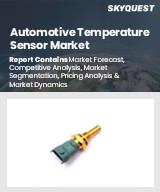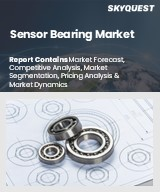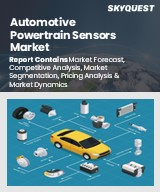
|
시장보고서
상품코드
1812558
온도 센서 시장 : 유형별, 지역별Temperature Sensors Market, By Type, By Geography |
||||||
온도 센서 시장은 2025년에 95억 2,000만 달러로 추정되며, 2032년에는 135억 8,000만 달러에 달할 전망이며, 2025-2032년의 연평균 성장률(CAGR)로 5.2%의 성장이 예측됩니다.
| 리포트 범위 | 리포트 상세 | ||
|---|---|---|---|
| 기준연도 | 2024 | 2025년 시장 규모 | 95억 2,000만 달러 |
| 실적 데이터 | 2020-2024년 | 예측 기간 | 2025-2032년 |
| 예측 기간 : 2025-2032년 CAGR : | 5.20% | 2032년 가치 예측 | 135억 8,000만 달러 |
세계 온도 센서 시장은 광범위한 산업 자동화 및 모니터링 생태계의 중요한 구성 요소이며, 다양한 용도에서 온도 변화를 감지하고 판독 가능한 전기 신호로 변환하는 필수적인 측정 장치로 작용합니다. 이러한 정교한 센싱 기술은 단순한 온도 조절기에서 뛰어난 정밀도와 신뢰성을 유지하면서 열악한 환경에서도 작동할 수 있는 고정밀 디지털 통합 시스템으로 발전해 왔습니다. 온도 센서에는 열전대, 저항 온도 감지기(RTD), 서미스터, 적외선 센서, 반도체 기반 센서 등 다양한 기술이 있으며, 각 기술은 특정 작동 요건에 따라 고유한 장점을 제공합니다.
이 시장은 자동차, 헬스케어, 항공우주, 식품 및 음료, 석유 및 가스, 화학 처리, 가전제품 등 다양한 최종 사용 산업에 걸쳐 있으며, 정확한 온도 모니터링이 안전, 품질관리 및 업무 효율성의 기본이 되고 있습니다. 최근 온도 센서는 무선 연결, 자가 교정 기능, 사물인터넷(IoT) 플랫폼과의 통합과 같은 스마트한 기능을 점점 더 많이 도입하여 실시간 데이터 분석 및 예지보전 전략을 가능하게 하고 있습니다.
시장 역학
세계 온도 센서 시장은 여러 산업과 지역에 걸쳐 견고한 성장 궤도를 추진하는 몇 가지 주요 요인에 의해 지원되고 있습니다. 산업용 사물인터넷(IIoT)과 인더스트리 4.0 구상의 채택이 가속화되고 있는 것이 주요 성장 요인이며, 제조업체들은 운영 효율성 최적화, 다운타임 감소, 예지보전 전략 실현을 위해 스마트 온도 모니터링 시스템 통합을 추진하고 있습니다. 식품 및 음료 산업에서 식품 안전 규정 준수 및 품질 보증에 대한 관심이 높아지면서 생산, 보관, 유통 과정에서 온도 센서에 대한 수요가 지속적으로 증가하고 있습니다.
그러나 특히 중소기업의 경우, 첨단 센서 기술에 따른 높은 초기 비용, 첨단 센서와 기존 레거시 시스템과의 통합의 복잡성 등 시장 성장의 걸림돌로 작용하고 있습니다. 센서 교정, 유지보수 요건, 열악한 산업 환경에서의 전문 지식의 필요성 등 기술적인 문제도 시장 확대에 걸림돌로 작용하고 있습니다.
이러한 과제에도 불구하고 확대되는 재생에너지 분야는 큰 비즈니스 기회를 창출하고 있으며, 태양전지판의 효율 모니터링과 풍력 터빈의 열 관리에서 온도 센서가 중요한 역할을 하고 있습니다. 확장되는 스마트 시티 개념과 빌딩 자동화 시스템은 HVAC 최적화 및 에너지 관리 용도에 온도 센서를 적용하는 데 유리한 기회를 제공합니다. 또한 아시아태평양과 라틴아메리카의 신흥 시장은 산업 현대화 및 인프라 개발로 인해 큰 성장 잠재력을 가지고 있습니다.
본 조사의 주요 특징
- 이 리포트는 세계의 온도 센서 시장을 상세하게 분석하고, 2024년을 기준연도로 한 예측 기간(2025-2032년)의 시장 규모(10억 달러)와 연평균 성장률(CAGR%)을 게재하고 있습니다.
- 또한 다양한 부문에 걸친 잠재적 매출 기회를 밝히고, 이 시장의 매력적인 투자 제안 매트릭스를 설명합니다.
- 또한 시장 성장 촉진요인, 억제요인, 기회, 신제품 출시 및 승인, 시장 동향, 지역별 전망, 주요 기업의 경쟁 전략 등에 대한 주요 인사이트를 제공합니다.
- 이 보고서는 기업 하이라이트, 제품 포트폴리오, 주요 하이라이트, 재무 성과, 전략 등의 매개 변수를 기반으로 세계 온도 센서 시장의 주요 기업을 프로파일링합니다.
- 이 보고서의 인사이트를 통해 마케팅 담당자와 기업 경영진은 향후 제품 출시, 유형 업그레이드, 시장 확대, 마케팅 전술에 대한 정보에 입각한 의사결정을 내릴 수 있습니다.
- 이 보고서는 투자자, 공급업체, 제품 제조업체, 유통업체, 신규 시장 진출기업, 재무 분석가 등 업계의 다양한 이해관계자를 대상으로 합니다.
- 이해관계자들은 세계 온도 센서 시장 분석에 사용되는 다양한 전략 매트릭스를 통해 의사결정을 용이하게 할 수 있습니다.
목차
제1장 조사의 목적과 전제조건
- 조사 목적
- 전제조건
- 약어
제2장 시장 전망
- 리포트 설명
- 시장의 정의와 범위
- 개요
제3장 시장 역학, 규제, 동향 분석
- 시장 역학
- 영향 분석
- 주요 하이라이트
- 규제 시나리오
- 제품 발매/승인
- PEST 분석
- PORTER의 산업 분석
- 시장 기회
- 규제 시나리오
- 주요 발전
- 업계 동향
제4장 세계의 온도 센서 시장, 유형별, 2020-2032년
- 열전대
- 저항 온도 검출기
- 적외선 센서
- 온도 센서 IC
- 서미스터
- 광섬유 센서
- 온도 트랜스미터
제5장 세계의 온도 센서 시장, 지역별, 2020-2032년
- 북미
- 미국
- 캐나다
- 라틴아메리카
- 브라질
- 아르헨티나
- 멕시코
- 기타 라틴아메리카
- 유럽
- 독일
- 영국
- 스페인
- 프랑스
- 이탈리아
- 러시아
- 기타 유럽
- 아시아태평양
- 중국
- 인도
- 일본
- 호주
- 한국
- ASEAN
- 기타 아시아태평양
- 중동
- GCC 국가
- 이스라엘
- 기타 중동
- 아프리카
- 남아프리카
- 북아프리카
- 중앙아프리카
제6장 경쟁 구도
- STMicroelectronics
- Siemens AG
- Ultra Electronics Holdings Plc.
- Maxim Integrated
- TE Connectivity
- Texas Instruments
- UTC Aerospace Systems
- ABB Ltd.
- Analog Devices Inc.
- Emerson Electric
- Honeywell International
- Fluke
- OMRON
- IFM Electronic
- Turck
제7장 애널리스트의 권장사항
- 기회
- 애널리스트의 견해
- Coherent Opportunity Map
제8장 참고 문헌과 조사 방법
- 참고 문헌
- 조사 방법
- 출판사 소개
Temperature Sensors Market is estimated to be valued at USD 9.52 Bn in 2025 and is expected to reach USD 13.58 Bn by 2032, growing at a compound annual growth rate (CAGR) of 5.2% from 2025 to 2032.
| Report Coverage | Report Details | ||
|---|---|---|---|
| Base Year: | 2024 | Market Size in 2025: | USD 9.52 Bn |
| Historical Data for: | 2020 To 2024 | Forecast Period: | 2025 To 2032 |
| Forecast Period 2025 to 2032 CAGR: | 5.20% | 2032 Value Projection: | USD 13.58 Bn |
The global temperature sensors market represents a critical component of the broader industrial automation and monitoring ecosystem, serving as essential measurement devices that detect and convert temperature variations into readable electrical signals across diverse applications. These sophisticated sensing technologies have evolved from simple thermostats to highly precise, digitally integrated systems capable of operating in extreme environments while maintaining exceptional accuracy and reliability. Temperature sensors encompass various technologies including thermocouples, resistance temperature detectors (RTDs), thermistors, infrared sensors, and semiconductor-based sensors, each offering unique advantages for specific operational requirements.
The market spans multiple end-use industries including automotive, healthcare, aerospace, food and beverage, oil and gas, chemical processing, and consumer electronics, where precise temperature monitoring is fundamental for safety, quality control, and operational efficiency. Modern temperature sensors increasingly incorporate smart features such as wireless connectivity, self-calibration capabilities, and integration with Internet of Things (IoT) platforms, enabling real-time data analytics and predictive maintenance strategies.
Market Dynamics
The global temperature sensors market is propelled by several key drivers that collectively fuel its robust growth trajectory across multiple industries and geographic regions. The accelerating adoption of Industrial Internet of Things (IIoT) and Industry 4.0 initiatives represents a primary growth driver, as manufacturers increasingly integrate smart temperature monitoring systems to optimize operational efficiency, reduce downtime, and enable predictive maintenance strategies. The food and beverage industry's growing focus on food safety compliance and quality assurance drives consistent demand for temperature sensors throughout production, storage, and distribution processes.
However, market growth faces certain restraints including the high initial costs associated with advanced sensor technologies, particularly for small and medium enterprises, and the complexity of integrating sophisticated sensors with existing legacy systems. Technical challenges related to sensor calibration, maintenance requirements, and the need for specialized expertise in harsh industrial environments also pose obstacles to market expansion.
Despite these challenges, significant opportunities emerge from the expanding renewable energy sector, where temperature sensors play crucial roles in solar panel efficiency monitoring and wind turbine thermal management. The growing smart cities initiatives and building automation systems present lucrative opportunities for temperature sensor deployment in HVAC optimization and energy management applications. Additionally, emerging markets in Asia Pacific and Latin America offer substantial growth potential driven by industrial modernization and infrastructure development.
Key Features of the Study
- This report provides in-depth analysis of the global temperature sensors market, and provides market size (USD Bn) and compound annual growth rate (CAGR%) for the forecast period (2025-2032), considering 2024 as the base year.
- It elucidates potential revenue opportunities across different segments and explains attractive investment proposition matrices for this market.
- This study also provides key insights about market drivers, restraints, opportunities, new product launches or approvals, market trends, regional outlook, and competitive strategies adopted by key players.
- It profiles key players in the global temperature sensors market based on the following parameters - company highlights, products portfolio, key highlights, financial performance, and strategies.
- Key companies covered as a part of this study include STMicroelectronics, Siemens AG, Ultra Electronics Holdings Plc., Maxim Integrated, TE Connectivity, Texas Instruments, UTC Aerospace Systems, ABB Ltd., Analog Devices Inc., Emerson Electric, Honeywell International, Fluke, OMRON, IFM Electronic, and Turck.
- Insights from this report would allow marketers and the management authorities of the companies to make informed decisions regarding their future product launches, type up-gradation, market expansion, and marketing tactics.
- The global temperature sensors market report caters to various stakeholders in this industry including investors, suppliers, product manufacturers, distributors, new entrants, and financial analysts.
- Stakeholders would have ease in decision-making through various strategy matrices used in analyzing the global temperature sensors market.
Market Segmentation
- Type Insights (Revenue, USD Bn, 2020 - 2032)
- Thermocouples
- Resistance Temperature Detectors
- Infrared Sensors
- Temperature Sensor ICs
- Thermistors
- Fiber-optic Sensors
- Temperature Transmitters
- Regional Insights (Revenue, USD Bn, 2020 - 2032)
- North America
- U.S.
- Canada
- Latin America
- Brazil
- Argentina
- Mexico
- Rest of Latin America
- Europe
- Germany
- U.K.
- Spain
- France
- Italy
- Russia
- Rest of Europe
- Asia Pacific
- China
- India
- Japan
- Australia
- South Korea
- ASEAN
- Rest of Asia Pacific
- Middle East
- GCC Countries
- Israel
- Rest of Middle East
- Africa
- South Africa
- North Africa
- Central Africa
- Key Players Insights
- STMicroelectronics
- Siemens AG
- Ultra Electronics Holdings Plc.
- Maxim Integrated
- TE Connectivity
- Texas Instruments
- UTC Aerospace Systems
- ABB Ltd.
- Analog Devices Inc.
- Emerson Electric
- Honeywell International
- Fluke
- OMRON
- IFM Electronic
- Turck
Table of Contents
1. Research Objectives and Assumptions
- Research Objectives
- Assumptions
- Abbreviations
2. Market Purview
- Report Description
- Market Definition and Scope
- Executive Summary
- Global Temperature Sensors Market, By Type
- Global Temperature Sensors Market, By Region
3. Market Dynamics, Regulations, and Trends Analysis
- Market Dynamics
- Impact Analysis
- Key Highlights
- Regulatory Scenario
- Product Launches/Approvals
- PEST Analysis
- PORTER's Analysis
- Market Opportunities
- Regulatory Scenario
- Key Developments
- Industry Trends
4. Global Temperature Sensors Market, By Type, 2020-2032, (USD Bn)
- Introduction
- Market Share Analysis, 2025 and 2032 (%)
- Y-o-Y Growth Analysis, 2021 - 2032
- Segment Trends
- Thermocouples
- Introduction
- Market Size and Forecast, and Y-o-Y Growth, 2020-2032, (USD Bn)
- Resistance Temperature Detectors
- Introduction
- Market Size and Forecast, and Y-o-Y Growth, 2020-2032, (USD Bn)
- Infrared Sensors
- Introduction
- Market Size and Forecast, and Y-o-Y Growth, 2020-2032, (USD Bn)
- Temperature Sensor ICs
- Introduction
- Market Size and Forecast, and Y-o-Y Growth, 2020-2032, (USD Bn)
- Thermistors
- Introduction
- Market Size and Forecast, and Y-o-Y Growth, 2020-2032, (USD Bn)
- Fiber-optic Sensors
- Introduction
- Market Size and Forecast, and Y-o-Y Growth, 2020-2032, (USD Bn)
- Temperature Transmitters
- Introduction
- Market Size and Forecast, and Y-o-Y Growth, 2020-2032, (USD Bn)
5. Global Temperature Sensors Market, By Region, 2020 - 2032, Value (USD Bn)
- Introduction
- Market Share (%) Analysis, 2025, 2028 & 2032, Value (USD Bn)
- Market Y-o-Y Growth Analysis (%), 2021 - 2032, Value (USD Bn)
- Regional Trends
- North America
- Introduction
- Market Size and Forecast, By Type, 2020 - 2032, Value (USD Bn)
- Market Size and Forecast, By Country, 2020 - 2032, Value (USD Bn)
- U.S.
- Canada
- Latin America
- Introduction
- Market Size and Forecast, By Type, 2020 - 2032, Value (USD Bn)
- Market Size and Forecast, By Country, 2020 - 2032, Value (USD Bn)
- Brazil
- Argentina
- Mexico
- Rest of Latin America
- Europe
- Introduction
- Market Size and Forecast, By Type, 2020 - 2032, Value (USD Bn)
- Market Size and Forecast, By Country, 2020 - 2032, Value (USD Bn)
- Germany
- U.K.
- Spain
- France
- Italy
- Russia
- Rest of Europe
- Asia Pacific
- Introduction
- Market Size and Forecast, By Type, 2020 - 2032, Value (USD Bn)
- Market Size and Forecast, By Country, 2020 - 2032, Value (USD Bn)
- China
- India
- Japan
- Australia
- South Korea
- ASEAN
- Rest of Asia Pacific
- Middle East
- Introduction
- Market Size and Forecast, By Type, 2020 - 2032, Value (USD Bn)
- Market Size and Forecast, By Country, 2020 - 2032, Value (USD Bn)
- GCC Countries
- Israel
- Rest of Middle East
- Africa
- Introduction
- Market Size and Forecast, By Type, 2020 - 2032, Value (USD Bn)
- Market Size and Forecast, By Country/Region, 2020 - 2032, Value (USD Bn)
- South Africa
- North Africa
- Central Africa
6. Competitive Landscape
- STMicroelectronics
- Company Highlights
- Product Portfolio
- Key Developments
- Financial Performance
- Strategies
- Siemens AG
- Company Highlights
- Product Portfolio
- Key Developments
- Financial Performance
- Strategies
- Ultra Electronics Holdings Plc.
- Company Highlights
- Product Portfolio
- Key Developments
- Financial Performance
- Strategies
- Maxim Integrated
- Company Highlights
- Product Portfolio
- Key Developments
- Financial Performance
- Strategies
- TE Connectivity
- Company Highlights
- Product Portfolio
- Key Developments
- Financial Performance
- Strategies
- Texas Instruments
- Company Highlights
- Product Portfolio
- Key Developments
- Financial Performance
- Strategies
- UTC Aerospace Systems
- Company Highlights
- Product Portfolio
- Key Developments
- Financial Performance
- Strategies
- ABB Ltd.
- Company Highlights
- Product Portfolio
- Key Developments
- Financial Performance
- Strategies
- Analog Devices Inc.
- Company Highlights
- Product Portfolio
- Key Developments
- Financial Performance
- Strategies
- Emerson Electric
- Company Highlights
- Product Portfolio
- Key Developments
- Financial Performance
- Strategies
- Honeywell International
- Company Highlights
- Product Portfolio
- Key Developments
- Financial Performance
- Strategies
- Fluke
- Company Highlights
- Product Portfolio
- Key Developments
- Financial Performance
- Strategies
- OMRON
- Company Highlights
- Product Portfolio
- Key Developments
- Financial Performance
- Strategies
- IFM Electronic
- Company Highlights
- Product Portfolio
- Key Developments
- Financial Performance
- Strategies
- Turck
- Company Highlights
- Product Portfolio
- Key Developments
- Financial Performance
- Strategies
7. Analyst Recommendations
- Wheel of Fortune
- Analyst View
- Coherent Opportunity Map
8. References and Research Methodology
- References
- Research Methodology
- About us



















